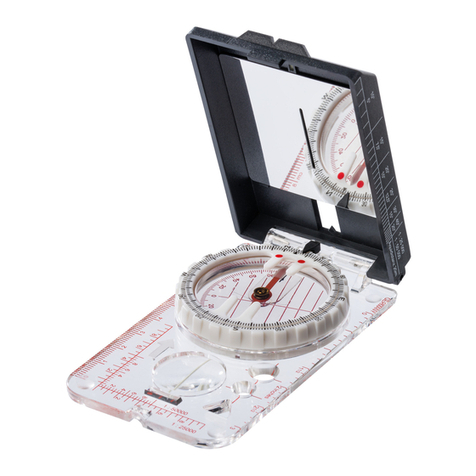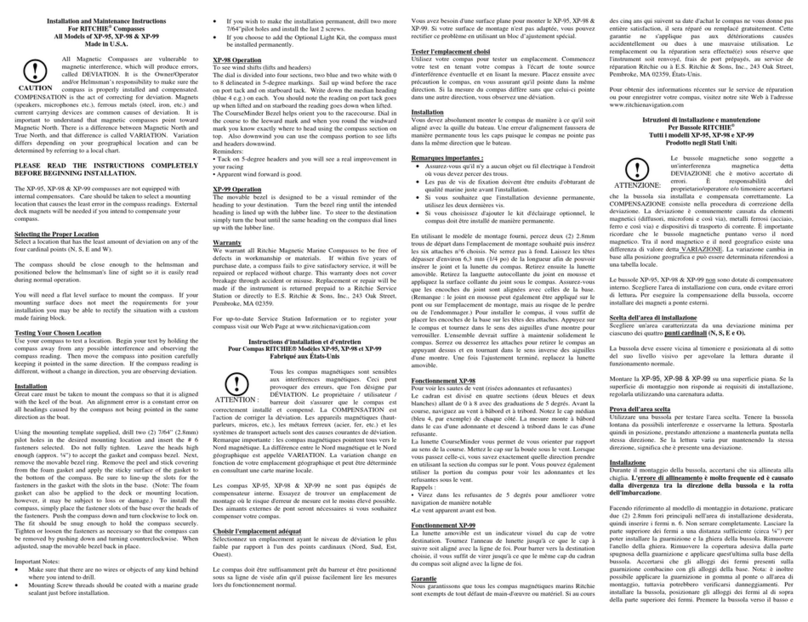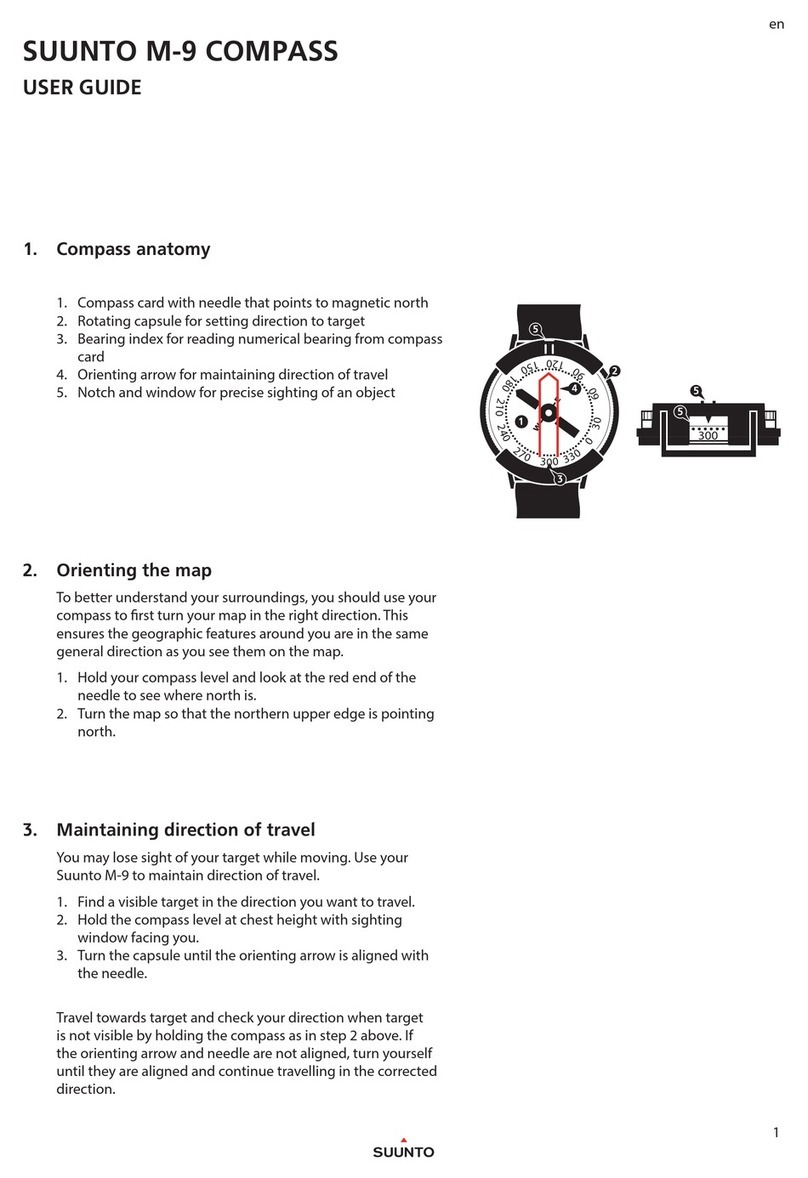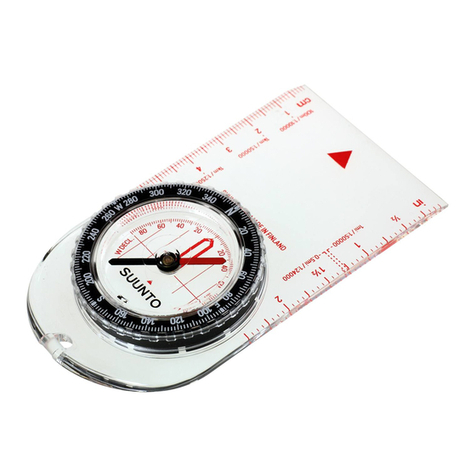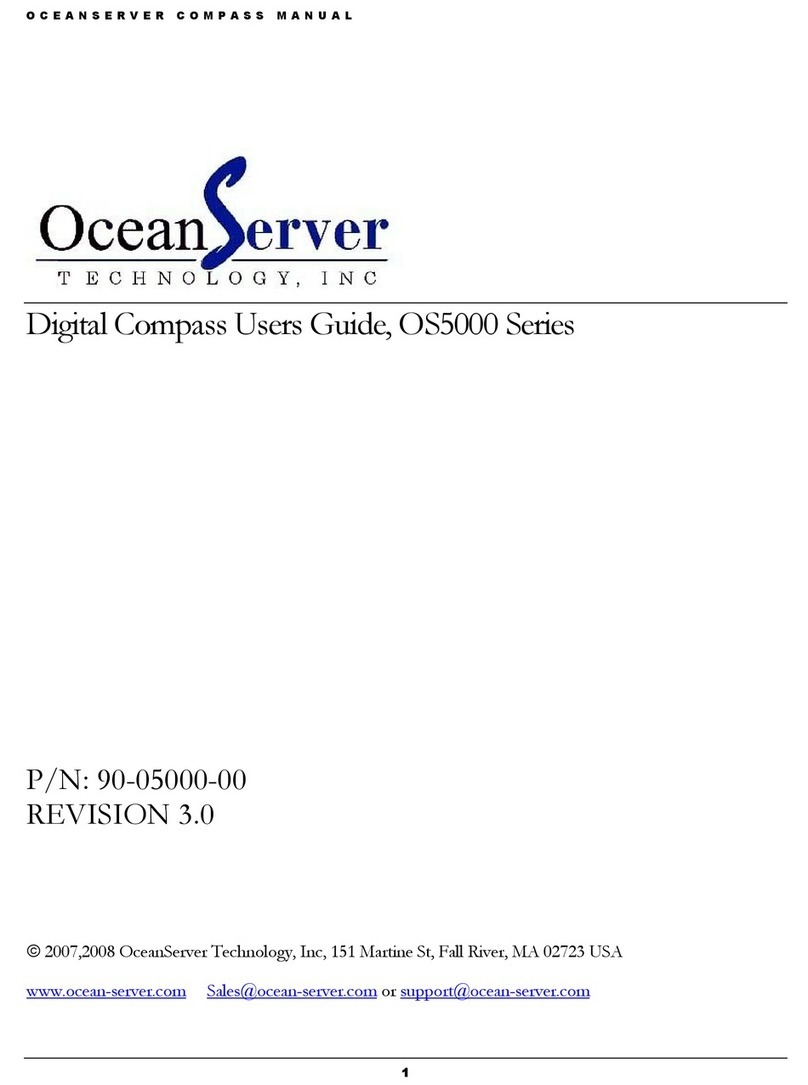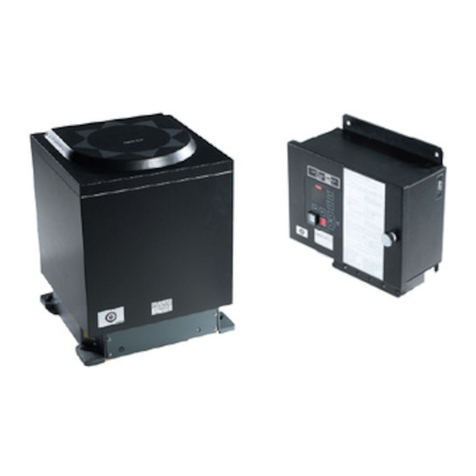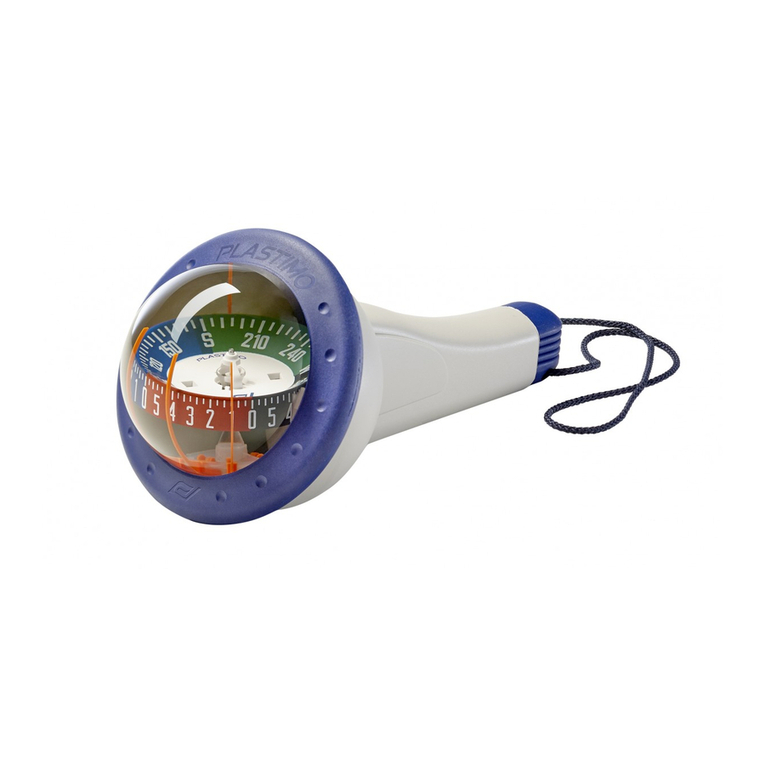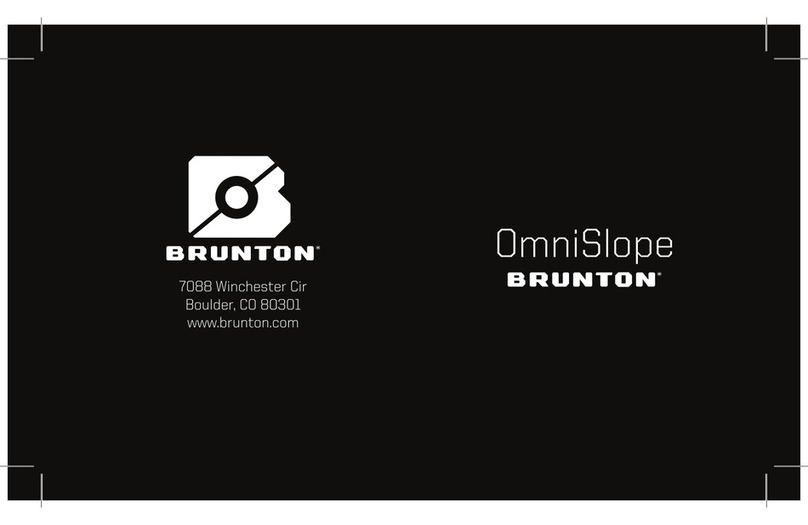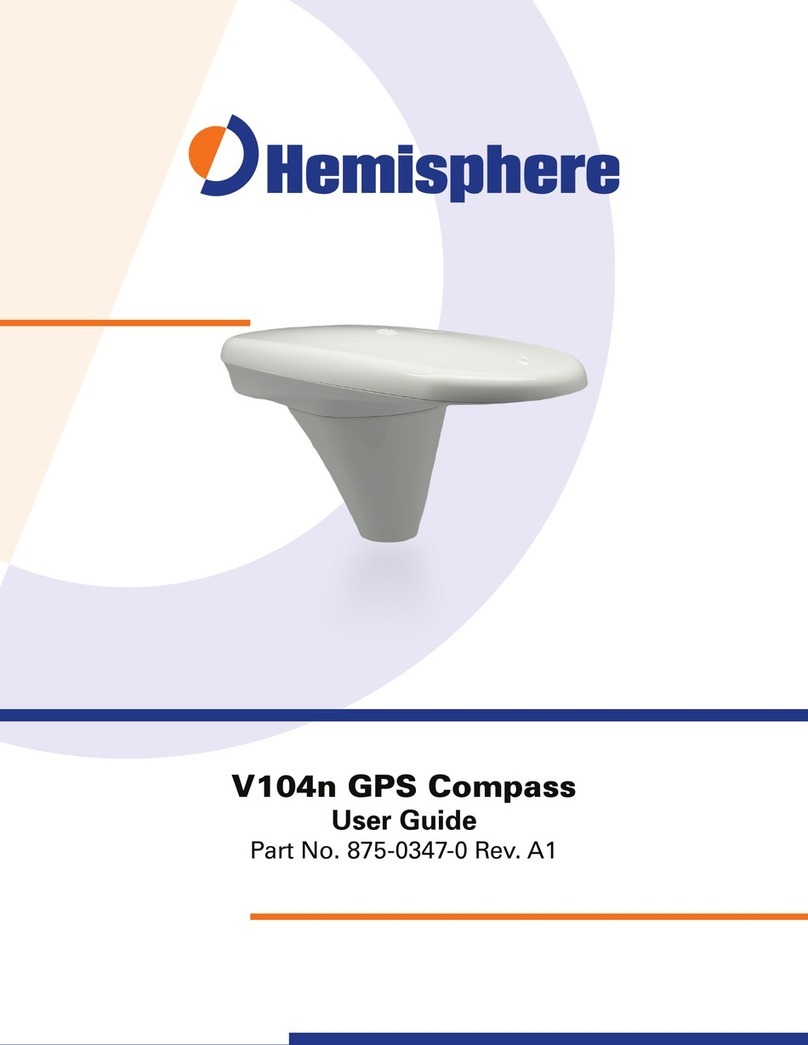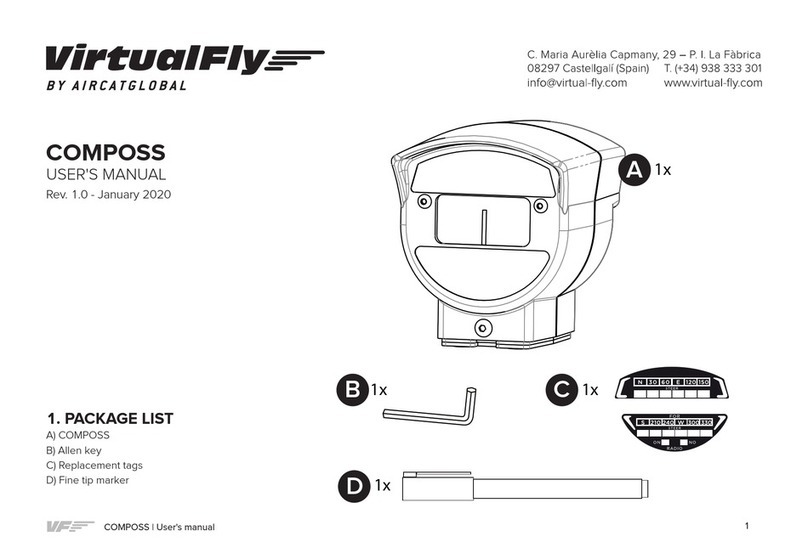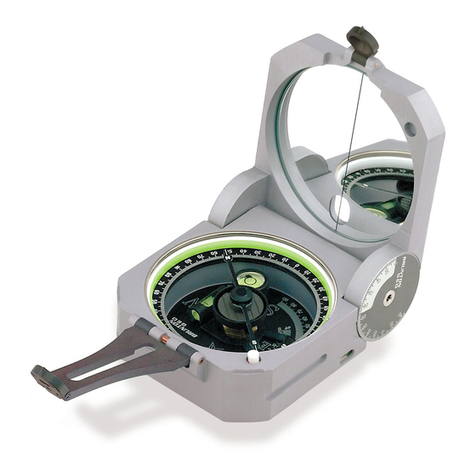barfield SC 063 Operator's manual

Copyright © 2022. Barfield Inc. All Rights Reserved
SC063
Sight Compass
USER INSTRUCTION MANUAL
M/N: SC063, P/N: 101-01200
Doc. P/N: 56-101-01200
Revision G
November 9, 2022
__________________________________________
SC063 is designed to be used as
Ground Support Test Equipment.
Not for aircraft installation.

56-101-01200 Revision G Page ii
Corporate Headquarters
4101 Northwest 29thStreet
Miami, Florida 33142
www.barfieldinc.com
Email: [email protected]
Barfield Inc. Confidential and Proprietary Information.
This document and all the information contained herein is the sole property of Barfield Inc.
No intellectual property rights are granted by the delivery of this document or the disclosure of its content.
This entire document is proprietary information and shall not be reproduced or disclosed to a third party
without the express written consent of Barfield Inc.
This document and its content shall not be used for any purpose other than that for which it is supplied.

56-101-01200 Revision G Page iii
CONTACT INFORMATION
Users are requested to notify the manufacturer of any discrepancy, omission, or error found in this
manual. Inquiries should include specific questions and reference the publication title, number, chapter,
page, figure, paragraph, and effective date.
Please send comments to:
TECHNICAL CUSTOMER SUPPORT - GSTE
BARFIELD, INC.
P.O. BOX 025367
MIAMI, FL 33102-5367
USA
Telephone (305) 894-5400
(800) 321-1039
Fax (305) 894-5401
Email gsesales@barfieldinc.com

56-101-01200 Revision G Page iv
MAINTENANCE AND REPAIR INFORMATION
The manufacturer of this equipment does not recommend the user to attempt any maintenance or repair.
In case of malfunction, contact the manufacturer to obtain the list of approved repair facilities worldwide,
ensuring that this equipment will be serviced using proper procedures and certified instruments.
BARFIELD PRODUCT SUPPORT DIVISION
Telephone (305) 894-5400
(800) 321-1039
Fax (305) 894-5401
Email gsesales@barfieldinc.com
Shipping Address:
Barfield, Inc.
4101 NW 29th Street
Miami, Florida 33142
USA
Mailing Address:
Barfield, Inc.
P.O. Box 025367
Miami, FL 33102-5367
USA

56-101-01200 Revision G Page v
REVISION RECORD
REV.
ECO #
REV. DATE
DESCRIPTION OF CHANGE
A
N/A
January 1983
Initial Release.
B
260-00680
October 5, 2006
Page number sequence was changed.
C
260-00702
July 16, 2007
List of Approved Repair Facilities was
updated. Description Section was modified
to reflect current accessories package
(short handle is no longer provided)
D
260-00782
September 9, 2010
Non-applicable sections were removed.
Disclaimer and Recertification paragraphs
were added.
E
260-01057
November 7, 2014
Barfield logo updated.
F
260-01269
June 26, 2020
Updated formatting; Minor grammar
revisions; Addition to Title Page and TOC –
List of Tables; Addition of Publication
Background and Specifications; corrected
color identified in Chapter 1, 1(E) from red
to orange.
G
260-01391
November 9, 2022
Revision of Introduction and Chapter 1.
Addition of Figures 5 & 6, Table 1, and
Chapter 2: Installation.

56-101-01200 Revision G Page vi
TABLE OF CONTENTS
Contact Information
Maintenance and Repair Information
Revision Record
Table of Contents
List of Figures
List of Tables
PAGE
INTRODUCTION................................................................................................................................... 1
1. PUBLICATION BREAKDOWN....................................................................................................1
2. INFORMATION PROVIDED WITH THE UNIT ............................................................................ 1
3. RECERTIFICATION.................................................................................................................... 2
4. DISCLAIMER.............................................................................................................................. 3
CHAPTER 1: GENERAL....................................................................................................................... 5
1. INTENDED USE ......................................................................................................................... 5
2. SPECIFICATIONS...................................................................................................................... 6
3. BACKGROUND INFORMATION................................................................................................. 6
CHAPTER 2: INSTALLATION.............................................................................................................. 8
1. ASSEMBLY................................................................................................................................. 8
CHAPTER 3: OPERATION................................................................................................................... 9
1. ESTABLISHING A PERMANENT REFERENCE POINT............................................................. 9
2. TESTING SIGHT SUITABILITY .................................................................................................. 9
3. VERIFYING EXISTING SWINGING BASE................................................................................ 10
4. DETERMINING MAGNETIC HEADING OF AN AIRCRAFT...................................................... 10
5. PRECOMPENSATION AND PRESWING INSTRUCTIONS...................................................... 10
6. COMPASS COMPENSATION PROCEDURE........................................................................... 11
7. COMPASS SWINGING PROCEDURE ..................................................................................... 12
CHAPTER 4: CARE PROCEDURES .................................................................................................. 14
1. HANDLING ............................................................................................................................... 14
2. STORAGE ................................................................................................................................ 14
CHAPTER 5: RECEIVING & SHIPPING ............................................................................................. 15
1. RECEIVING.............................................................................................................................. 15
2. SHIPPING................................................................................................................................. 15

56-101-01200 Revision G Page vii
LIST OF FIGURES
PAGE
Figure 1 Identification Label.................................................................................................................1
Figure 2 Owner Warranty Registration Card ........................................................................................2
Figure 3 Limited One Year Warranty....................................................................................................4
Figure 4 Sight Compass....................................................................................................................... 5
Figure 5 Container / Shipping Case, P/N 194-00078............................................................................ 8
LIST OF TABLES
PAGE
Table 1 Physical Characteristics...........................................................................................................6
Table 2 Compass Worksheet ............................................................................................................. 13
Table 3 Example of Completed Compass Correction Worksheet ....................................................... 13

56-101-01200 Revision F Page 1
INTRODUCTION
1. PUBLICATION BREAKDOWN
This user instruction manual establishes the standards of operation for the Sight Compass, M/N
SC063, P/N 101-01200.
Its purpose is to provide sufficient information for the personnel unfamiliar with this unit to operate it
in accordance with proper procedures, operating techniques, precautions, and limitations.
Note: The manufacturer has designed this equipment to be safe when operated using the
procedures and instructions detailed in this manual. Do not use this equipment for any
other purpose than that stated, as the protection provided by the equipment may be
impaired.
2. INFORMATION PROVIDED WITH THE UNIT
In addition to this User Instruction Manual, the Sight Compass is delivered with the items described
below.
A. The identification label (similar to Figure 1) attached to the instrument, provides the following
information:
Manufacturer Name
Designation of Equipment
Equipment Part Number
Equipment Model Number Equipment Serial Number
Figure 1 Identification Label
SIGHT COMPASS
101-01200
SC063
####

56-101-01200 Revision G Page 2
B. A laminated instruction sheet card, with a summary of the most frequently used operating
instructions indicated in this manual. This card is not intended to be a substitute of this manual;
it is provided as a quick reference card that can be conveniently carried to the location where
the procedures involving the aircraft will be performed.
C. The Owner’s Warranty Registration card (refer to Figure 2) is to be completed by the owner and
returned to Barfield, Inc. within ten (10) days of purchase to ensure automatic update of printed
matter and validation of warranty.
To register your unit, please visit https://www.barfieldinc.com/warranty_registration or scan the
QR code on the supplied Warranty Registration.
Figure 2 Owner Warranty Registration Card
D. Each new or re-certified unit is delivered with a Certificate (not pictured) that shows the date
when the unit was tested by the manufacturer, its serial number and when the next certification
is due. This certificate confirms that the unit performed according to its design specifications.
E. The Limited Warranty Statement (refer to Figure 3) lists the manufacturer’s obligation to the
original purchaser.
3. RECERTIFICATION
The Barfield Sight Compass, M/N SC063, P/N 101-01200, has a one-year recertification
requirement. Maintenance required by this unit must be performed by qualified technicians in a
shop equipped with the necessary tooling and facilities. Contact Barfield for Maintenance and
Calibration requirements.

56-101-01200 Revision G Page 3
4. DISCLAIMER
BARFIELD, INC., neither a vendor nor supplier of airworthy compasses or an airframe
manufacturer, has control over aircraft calibration and certification procedures. The information
provided in this Instruction Manual is presented as reference only, and therefore the compass
manufacturer calibration procedures and aircraft maintenance manual shall take precedence over
this Manual. However, the information presented is correct to the best of our knowledge at the time
of publication.

56-101-01200 Revision G Page 4
Figure 3 Limited One Year Warranty

56-101-01200 Revision G Page 5
CHAPTER 1: GENERAL
1. INTENDED USE
A. The BARFIELD INC. SC063 Sight Compass (P/N 101-01200) is a modified version of a
standby Aircraft Compass that had its compensating assembly removed and collimator sight
attached (refer to Figure 4). It can be used for determining the magnetic suitability of a Compass
swinging area, checking and laying out Compass swinging bases, and determining the magnetic
heading of an aircraft.
Note: Since the Sight Compass is used extensively when a prepared base is not available,
operating personnel should be familiar with its three uses and method of checking its
accuracy.
B. Modified features include:
1. Reversed magnetic polarity, which permit the operator of the Sight Compass to view the
aircraft being checked from the front. This makes communications (hand signals) between
the aircraft occupant and the Sight Compass operator convenient.
2. Attached to the front of the Sight Compass is a combination magnifying lens (to increase the
readability of the dial) and a collimating lens (to ensure precise sighting alignment).
3. Attached to the rear of the Compass is an adjustable Sight Lens. The lens is precisely
aligned to ensure that the overall accuracy of the dial falls within ± 1°.
4. The Compass is mounted on a bracket, which can be attached to a monopod assembly
(supplied with the Sight Compass).
5. The Sight Compass is painted orange and has a caution label attached to it to prevent
inadvertent installation in an aircraft.
6. The SC063 Sight Compass is packaged in a protective carrying case.
Figure 4 Sight Compass

56-101-01200 Revision G Page 6
2. SPECIFICATIONS
A. Physical Data
Size (H, W, L)
3.34 in. (8.5 cm), 2.36 (6 cm), 2.75 in. (7 cm)
Weight
0.72 lbs. (0.325 kg)
Table 1 Physical Characteristics
B. Scale
The Sight Compass is marked with letters representing the cardinal directions, North (N), East
(E), South (S), and West (W), and a number for each 30 degrees between these letters. For
example, 3 = 30°, 6 = 60°, and 33 = 330°.
There are long and short graduation marks between the letters and numbers, with each long
mark representing 10 degrees and each short mark representing 5 degrees.
C. Accuracy
Accurate to within ±1 degrees.
3. BACKGROUND INFORMATION
A. A compass swing must be performed whenever any ferrous component of the system (i.e., flux
valve compensator, or Standby Compass) is installed, removed, repaired or a new compass is
installed. Additionally, a compass swing must be performed on the following occasions:
1. When the accuracy of the Compass is suspected.
2. After any cockpit modification or major replacement involving ferrous metals.
3. When the Compass has been subjected to shock from a hard landing or turbulence.
4. After aircraft has passed through a severe electrical storm.
5. After a lightning strike.
6. Whenever a change is made to the electrical system.
7. Whenever a change of cargo is likely to affect the Compass.
8. Whenever an aircraft operation is changed to a new geographic location with a major
change in magnetic deviation.
9. After aircraft has been parked on one heading for over a year.
10. When flux valves are replaced.
B. Understanding Compass Errors
The error of any compass is the angular difference between true north and compass north. This
angle is the algebraic sum of the deviation and variation. These are two terms commonly used
in connection with compasses that should not be confused.
1. Compass deviation is the difference between the heading of the aircraft, as indicated by the
compass and the actual magnetic heading of the aircraft. The deviation is called plus or
minus (east or west respectively) to indicate how it must be applied to the compass heading

56-101-01200 Revision G Page 7
to obtain the actual magnetic heading. The deviation and its sign are determined by
subtracting the aircraft compass reading from the magnetic heading of the aircraft.
2. Variation is the difference between the direction indicated by an undisturbed magnetic
compass and the true direction measured in relation to the earth’s geographical North Pole.
C. Causes of Compass Errors
There are several causes for inaccuracy in aircraft compasses: namely faulty installation,
vibration, the Aircraft’s magnetism (metallic and electrical), northerly turning error and
acceleration error. Installation and vibration error can and should be corrected. Northerly turning
error and acceleration error are common in magnetic needle type compasses incorporating a
sensitive element, which may be tilted and cannot be corrected. Errors caused by the aircraft’s
magnetism should be corrected insofar as is practically possible. The aircraft compass is
compensated to accomplish this. Magnetism in aircraft, which is likely to affect the compass,
can be caused by the following:
1. Hard Iron
This term is given to those parts of the Aircraft, which may be regarded as permanent
magnets; that is, parts in which the magnetism tends to remain the same. The effect of hard
iron can be determined with fair accuracy during a compass swing. By using other
permanent magnets (compensating magnets) near the compass, it usually can be
completely compensated. Once such compensation has been accurately made, it will
remain effective so long as the magnets do not alter their strength or position. If the
compensation is not complete and some error remains in the compass, the error will alter as
the aircraft changes magnetic latitude. For this reason, the accurate correction of the
aircraft’s permanent magnetism is extremely important.
2. Soft Iron
This term is given to those parts of the aircraft which continuously change their magnetism,
depending on the influence of other magnets (such as earth) on them. The soft iron
magnetism will change the Compass deviation with the change of magnetic latitude if it
results from the presence of unsymmetrical, vertical soft iron near the Compass. The
compensation of an aircraft for soft iron magnetism is so complicated as to be impractical
and should be performed only by an expert. It is important, therefore, that the Compass
location be such that there is no soft iron near it.
3. Electrical Magnetism
This term is given to the magnets (magnetic fields) which are produced by a direct electrical
current flowing through a wire. Since the direct current, causing electrical magnetism, is
liable to change frequently during a flight, it is of the utmost importance that any single-pole
wires carrying a direct current should not pass anywhere near the compass. If it is
impossible to avoid this wiring, then it is essential that the wiring be of the two-pole type.
Experience has shown that the use of single-pole electrical wiring near the compass has
such a serious effect that it cannot be tolerated.

56-101-01200 Revision G Page 8
CHAPTER 2: INSTALLATION
1. ASSEMBLY
A. Package
A monopod assembly, which is provided in assorted lengths. Combinations of lengths may be
chosen to support the Sight Compass at the operator’s eye level. Although the Sight Compass
can be handheld, experience has shown that the use of the monopod provides more stable
sightings.
Note: All external parts of the Sight Compass, such as the mounting bracket and monopod,
have been selected to contain no materials which could affect the magnetic accuracy of
the Sight Compass. Any other support, such as a camera tripod, must be carefully
checked for the presence of any ferrous materials before being used.
B. Enclosure
1. A case, Barfield P/N 194-00078, which facilitates protecting and carrying the Sight
Compass. Case features include (refer to Figure 5):
a) An injected, molded case.
b) Airtight, watertight, and dustproof case.
c) Custom PE foam insert to secure Sight Compass in place.
Note: Refer to Figure 5 for proper Sight Compass orientation.
Figure 5 Container / Shipping Case, P/N 194-00078
2. A laminated instruction sheet card, Barfield P/N 60-101-01200.
Note: Please use latest revision.

56-101-01200 Revision G Page 9
CHAPTER 3: OPERATION
WARNING: Before performing the procedures indicated in this chapter, remove all personal items
which might contain ferrous material, such as keys, pocketknives, watches, cell phones,
radios, pocket calculators, metal pens and pencils, etc. Beware of metal frame eyeglasses,
sunshades, metal shirt or jacket buttons, and steel belt buckles. All these items may be
magnetic, thus affecting the functioning of the Sight Compass.
1. ESTABLISHING A PERMANENT REFERENCE POINT
When the Sight Compass is first received, it is suggested that a permanent reference check point
be established. If, at any time, there is reason to suspect the readings obtained during the Aircraft
Compass testing, the Sight Compass can be rechecked using these reference points. To determine
one or more appropriate reference procedures:
A. Select an unobstructed view of at least 100 feet away from any buildings, machinery, fences,
power lines, etc. which could affect the magnetic environment. Beware of concrete runways with
embedded steel mesh or of any underground cables or pipelines. Also, the area selected should
be where future construction is unlikely. Battery Installation and Verification.
B. From the selected area, locate a prominent object at least 1 mile distant from the sighting
location. Again, try to anticipate an area where future construction is unlikely.
C. Remove all magnetic personal items that could affect the Compass. Clear the designated
location of any magnetic sources, induced electromagnetic field, or source of ferromagnetic
materials that could affect the Earth’s magnetic field. These items may include, but are not
limited to tools, cellphones, watches, jewelry and metal pens. These items must be removed
from the test set area, at least 5 feet away, to avoid adversely affecting the Compass reading.
Articles that must be worn, such as eyeglasses, should be checked and demagnetized
accordingly.
D. Carefully align the Compass sight on the chosen distant object or objects. Note and record the
Sight Compass readings.
E. Mark the observation point with some non-ferrous item for future reference.
F. Make a permanent record of the observation point, the referenced distant object or objects and
the Sight Compass readings.
2. TESTING SIGHT SUITABILITY
Before attempting to check and calibrate an Aircraft Compass, the area to be used should be
tested. It is recommended that the area be as far as possible from any magnetic disturbance.
Suggested distances are 50 feet from the aircraft being swung and 100 feet from any buildings,
large items of machinery, power lines, fences, etc. However, the area could appear to meet all of
these requirements but be unusable because of the steel mesh in the ramp or underground cables
or pipelines. To ascertain if the chosen area is satisfactory, proceed as follows:
A. Ensure that the area is at least 100 feet in diameter or adequate to accommodate the
dimensions of the aircraft being tested.

56-101-01200 Revision G Page 10
B. Check that a prominent object within the chosen area (at least a mile distant) can be observed.
C. Remove all magnetic personal items that could affect the Sight Compass.
D. Observe the distant object or objects from at least 8 points equidistant on the perimeter of the
chosen 100-foot diameter and note the Sight Compass readings.
E. If all readings are consistent within 1 degree, the area is satisfactory for Compass swinging.
However, the area should be rechecked frequently for possible magnetic charges.
In general, an area can be checked for Compass swinging suitability by taking bearings with the
Sight Compass from random positions within the area in question on an object at least a mile
distant. If all bearings are the same, the area is suitable for use.
3. VERIFYING EXISTING SWINGING BASE
To verify an existing base, the operator aligns himself/herself successively with the marked lines on
the base (standing at least 50 feet from the base) and sights along the line being checked with the
handheld, Sight Compass. If the bearings taken agree with the markings on the base, or the
markings plus or minus 90 degrees (in cases where the aircraft wheels are placed on the line), the
base is satisfactory. If a constant difference between the measured bearings and the markings of
the lines exists, the lines on the base should be redrawn. If the difference varies, the base is
unsuitable for use.
4. DETERMINING MAGNETIC HEADING OF AN AIRCRAFT
A. Standing at least 30 feet from the aircraft, the observer aligns himself/herself with its longitudinal
axis by reference to a radio mast and fin, row of central fuselage rivets or any suitable line or
pair of objects on the Aircraft, and with a handheld Sight Compass, sights on one of the objects
used for alignment. The Sight Compass is read when steadied. The reading obtained is the
magnetic heading of the aircraft if the observer is in front of the aircraft.
B. When using the Sight Compass, the aircraft’s nose is placed on the desired heading according
to the Aircraft Compass. Alignment on the heading need not be exact but should be within 5
degrees.
C. The Sight Compass should be supported and held at a comfortable reading distance from the
eye. A monopod is supplied with the Sight Compass to aid in steadying the Compass. Again,
the observer must take care to remove all magnetic material from his person prior to using the
Sight Compass.
5. PRECOMPENSATION AND PRESWING INSTRUCTIONS
A. When using the Sight Compass, the operator stands directly in front of the aircraft at a minimum
distance of 30 feet, preferably 50 feet or more.
B. The Compass is held as nearly level as possible and sighted through the sighting lens to the
exact center of the aircraft.

56-101-01200 Revision G Page 11
C. Sufficient time should be allowed for the Sight Compass to stabilize before taking readings. It is
best to take a series of three readings before assuming that the readings are correct.
D. Normal procedure is to either taxi or tow the aircraft to approximately the desired heading as
read on the Compass to be compensated (within 5 degrees).
E. The operator using the Sight Compass, then standing directly in front of the aircraft and with the
Sight properly lined on the center line of the aircraft, observes the exact heading on which the
aircraft is positioned, and notes any error that exists between the Sight Compass and the
Aircraft Compass being compensated.
F. Whatever error exists between the Sight Compass and the Aircraft heading is then corrected by
moving the Aircraft the number of degrees difference existing until such time as the Aircraft
heading and the reading of the Sight Compass are corrected for the desired heading (within 5
degrees).
G. It is of the utmost importance that during the swinging procedure a minimum distance of 30 feet
be maintained between the Aircraft being swung and the operator using the Sight Compass.
Also, the operator and the Sight Compass must be a minimum of 50 feet from any other aircraft,
or at least 100 feet from any large building, power lines, or heavy objects which might cause
interference.
H. Insofar as possible, all fixed or movable items containing ferrous materials should be placed in
positions they will occupy in flight before beginning the swing.
I. The Compass should be inspected for general serviceability.
J. An Aircraft Compass is easily affected by stray magnetism from electrical circuits and moveable
steel objects. Before swinging the Compass, the aircraft should be positioned approximately
north, east, south, and west. On each heading, the Compass should be observed with the
engine(s) operating and indicating generator charging, and with the engine(s) stopped. If a
significant difference is observed, the swinging should be done with the engines running and
charging. Also, on each heading, various electrical components should be turned ON and OFF
to determine their effect on the Compass. A determination must be made as to what equipment
will be used during the Compass swing. In some cases, multiple readings may be required to
cover normal, abnormal, and emergency conditions.
K. When swinging the Aircraft, it should be kept (as nearly as possible) in the center of the chosen
area. Since it is easier to move the Sight Compass than the aircraft, it is not essential that the
aircraft be precisely positioned on the selected headings. However, the aircraft should be within
5 degrees of the desired heading for best results. Also, during the actual compensating
procedure on north, east, south, and west, the alignment should be as close to the exact
heading as practical.
6. COMPASS COMPENSATION PROCEDURE
Note: All these corrections shall be made using a non-magnetic screwdriver. The Compass
shall be lightly tapped after each adjustment and be allowed time to settle before taking
readings.

56-101-01200 Revision G Page 12
A. Set the compensator for zero effect by matching the dots on the compensator screws with the
fixed dots on the case.
B. Align the Aircraft as nearly as possible (not to exceed 5 degrees error) to magnetic north (0°).
C. Turn the N-S screw to cause the Aircraft Compass to read the same as the Sight Compass.
D. Align the Aircraft as nearly as possible (not to exceed 5 degrees error) to magnetic east (90°).
E. Turn the E-W screw to cause the Aircraft Compass to read the same as the Sight Compass.
CAUTION: IF THE N-S SCREW IS INADVERTENTLY TURNED, THE NORTH HEADING
MUST BE RECHECKED AND COMPENSATED.
F. Align the aircraft as nearly as possible (not to exceed 5 degrees error) to magnetic south (180°).
G. Turn the N-S screw to remove one-half of the error between the Aircraft Compass and the Sight
Compass.
H. Align the Aircraft as nearly as possible (not to exceed 5 degrees error) to magnetic west (270°).
I. Turn the E-W screw to remove one-half of the error between the Aircraft Compass and the Sight
Compass.
7. COMPASS SWINGING PROCEDURE
A. Prepare a worksheet similar to the one shown in Table 2 by first making a copy of the blank
worksheet as shown in Table 1 and populating it with the data recorded and calculated by
accomplishing the steps that follow.
B. Starting on any convenient 30-degree heading, align the Aircraft so that the Sight Compass
reads within 5 degrees of the desired heading.
C. Record the Aircraft Compass reading in column 2 and the Sight Compass reading in column 3
adjacent to the appropriate heading in column 1.
D. Repeat steps 7.B and 7.C for each subsequent 30-degree heading.
E. Record the difference between the readings of the Aircraft and Sight Compass readings in
column 4.
F. Add or subtract the Compass errors in column 4, to or from, respectively, the desired headings
in column 1. Enter the results in column 5. Refer to Table 2 as a guide to these calculations.
G. There should not be more than plus or minus 10° difference between any of the Aircraft
Compass readings and the Sight Compass readings. If the Aircraft Compass cannot be
adjusted to meet the requirements, install another one.
H. Enter the values from column 5 in the “STEER” portion of the Aircraft Compass correction card.

56-101-01200 Revision G Page 13
(Column 1)
DESIRED
HEADING
(Column 2)
AIRCRAFT
COMPASS
READING
(Column 3)
SIGHT
COMPASS
READING
(Column 4)
AIRCRAFT
COMPASS
ERROR
(Column 5)
CORRECTED
AIRCRAFT
COMPASS
N
030
060
E
120
150
S
210
240
W
300
330
Table 2 Compass Worksheet
(Column 1)
DESIRED
HEADING
(Column 2)
AIRCRAFT
COMPASS
READING
(Column 3)
SIGHT
COMPASS
READING
(Column 4)
AIRCRAFT
COMPASS
ERROR
(Column 5)
CORRECTED
AIRCRAFT
COMPASS
N
356
359
-3
357
030
032
034
-2
028
060
062
063
-1
059
E
088
086
+2
092
120
125
121
+4
124
150
150
148
+2
152
S
177
175
+2
182
210
213
213
0
210
240
245
246
-1
239
W
268
270
-2
268
300
300
297
+3
303
330
333
335
-2
328
Table 3 Example of Completed Compass Correction Worksheet
Other manuals for SC 063
1
This manual suits for next models
1
Table of contents
Other barfield Compass manuals



